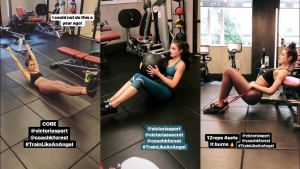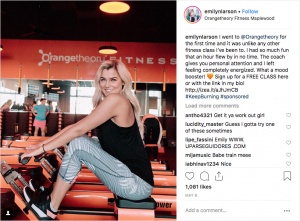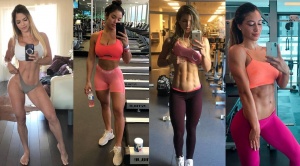Difference between revisions of "Fitness Influencers"
| Line 26: | Line 26: | ||
Last month, a study of TikTok’s fitness content revealed that “27% of the videos that were analyzed demonstrated bad form or incorrect advice.” <ref>Hosie, Rachel. [https://news.yahoo.com/5-red-flags-look-fitness-132254666.html "5 red flags to look for before you take fitness advice from influencers"] 16 Feb 2021. Retrieved on 11 Mar 2021.</ref><ref name = "fit">Hiley, Catherine. [https://www.money.co.uk/mobiles/fittok-report "The FitTok Report"] 1 Feb 2021. Retrieved on 11 Mar 2021.</ref> The same study looked at a variety of specific exercises and calculated what percentage of influencers were teaching incorrect form in their descriptions or demonstrations of that particular exercise; this percentage ranged from 12% to 80%. <ref name="fit"/> Social media users can learn incorrect form for different exercises if they try to imitate fitness influencers who are teaching it incorrectly. Consequently, these people are more susceptible to getting hurt because exercising with incorrect form can put people at risk for various injuries. <ref>Finch, Caroline F and Gray, Shannon E. [https://www.ncbi.nlm.nih.gov/pmc/articles/PMC5005555/ "The causes of injuries sustained at fitness facilities presenting to Victorian emergency departments - identifying the main culprits"] 14 Apr 2015. Retrieved on 11 Mar 2021.</ref><ref name="fit"/> | Last month, a study of TikTok’s fitness content revealed that “27% of the videos that were analyzed demonstrated bad form or incorrect advice.” <ref>Hosie, Rachel. [https://news.yahoo.com/5-red-flags-look-fitness-132254666.html "5 red flags to look for before you take fitness advice from influencers"] 16 Feb 2021. Retrieved on 11 Mar 2021.</ref><ref name = "fit">Hiley, Catherine. [https://www.money.co.uk/mobiles/fittok-report "The FitTok Report"] 1 Feb 2021. Retrieved on 11 Mar 2021.</ref> The same study looked at a variety of specific exercises and calculated what percentage of influencers were teaching incorrect form in their descriptions or demonstrations of that particular exercise; this percentage ranged from 12% to 80%. <ref name="fit"/> Social media users can learn incorrect form for different exercises if they try to imitate fitness influencers who are teaching it incorrectly. Consequently, these people are more susceptible to getting hurt because exercising with incorrect form can put people at risk for various injuries. <ref>Finch, Caroline F and Gray, Shannon E. [https://www.ncbi.nlm.nih.gov/pmc/articles/PMC5005555/ "The causes of injuries sustained at fitness facilities presenting to Victorian emergency departments - identifying the main culprits"] 14 Apr 2015. Retrieved on 11 Mar 2021.</ref><ref name="fit"/> | ||
| − | Fitness influencers tend to promote adhering to certain diets for a healthier lifestyle, some of which include keto and vegan diets. </ref><ref name = "nutrition">Lofft, Zoe. [https://www.healthscienceinquiry.com/index.php/hsi/article/view/319 "When social media met nutrition: How influencers spread misinformation, and why we believe them"] Aug 10 2020 Retrieved on 11 Mar 2021.</ref> Many of these diets are one-size-fits-all plans, assuming that the same dieting techniques are effective for everyone. <ref name="nutrition"/> These diet plans fail to address the fact that diets should be more individualized, and what is a healthy diet for one person may not be for another; thus, people adhering to influencers’ dieting advice might try diets that are not effective and possibly unhealthy for them. <ref name="nutrition"/> Many of these diets are also fad diets, which can be accompanied by health issues, such as low energy and constipation. <ref name = "fad">Khawandanah, Jomana and Tewfik, Ihab. [https://pdfs.semanticscholar.org/d420/46557810136fa0764363353cca9efcd10b59.pdf "Fad Diets: Lifestyle Promises and Health Challenges"] 16 Nov 2016 Retrieved on 11 Mar 2021.</ref> Oftentimes with fad diets, “weight loss occurs too fast, most of the lost weight being water and muscle, not fat tissue.” <ref name="fad"/> | + | Fitness influencers tend to promote adhering to certain diets for a healthier lifestyle, some of which include keto and vegan diets. </ref><ref name = "nutrition">Lofft, Zoe. [https://www.healthscienceinquiry.com/index.php/hsi/article/view/319 "When social media met nutrition: How influencers spread misinformation, and why we believe them"] Aug 10 2020. Retrieved on 11 Mar 2021.</ref> Many of these diets are one-size-fits-all plans, assuming that the same dieting techniques are effective for everyone. <ref name="nutrition"/> These diet plans fail to address the fact that diets should be more individualized, and what is a healthy diet for one person may not be for another; thus, people adhering to influencers’ dieting advice might try diets that are not effective and possibly unhealthy for them. <ref name="nutrition"/> Many of these diets are also fad diets, which can be accompanied by health issues, such as low energy and constipation. <ref name = "fad">Khawandanah, Jomana and Tewfik, Ihab. [https://pdfs.semanticscholar.org/d420/46557810136fa0764363353cca9efcd10b59.pdf "Fad Diets: Lifestyle Promises and Health Challenges"] 16 Nov 2016. Retrieved on 11 Mar 2021.</ref> Oftentimes with fad diets, “weight loss occurs too fast, most of the lost weight being water and muscle, not fat tissue.” <ref name="fad"/> |
Fitness influencers are usually attractive and often showcase their fit physiques to attract followers and get people to try their workouts or diets. <ref name="nutrition"/> The issue is that these creators’ envious physical appearances may be due to factors other than nutrition and exercise. Influencers could be genetically predisposed to having a certain body shape. <ref>Schlossberg , Mallory. [https://www.businessinsider.com/the-dangers-of-instagram-fitness-2016-7 "The dangers of Instagram fitness"] 23 Jul 2016. Retrieved on 11 Mar 2021.</ref> Posing, clothing choice, lighting, and editing are also contributing factors in how a person’s body appears in pictures. Many people assume that a fitness influencer’s physique can be attributed to the diets and exercise regimes that they recommend. <ref name="nutrition"/> But, if an influencer’s appearance is impacted by other factors, social media users might falsely believe the influencer’s fitness advice to be more impactful on one’s physique than it really is, possibly causing people to spend their time following diets and workout plans that fall short of expectations. | Fitness influencers are usually attractive and often showcase their fit physiques to attract followers and get people to try their workouts or diets. <ref name="nutrition"/> The issue is that these creators’ envious physical appearances may be due to factors other than nutrition and exercise. Influencers could be genetically predisposed to having a certain body shape. <ref>Schlossberg , Mallory. [https://www.businessinsider.com/the-dangers-of-instagram-fitness-2016-7 "The dangers of Instagram fitness"] 23 Jul 2016. Retrieved on 11 Mar 2021.</ref> Posing, clothing choice, lighting, and editing are also contributing factors in how a person’s body appears in pictures. Many people assume that a fitness influencer’s physique can be attributed to the diets and exercise regimes that they recommend. <ref name="nutrition"/> But, if an influencer’s appearance is impacted by other factors, social media users might falsely believe the influencer’s fitness advice to be more impactful on one’s physique than it really is, possibly causing people to spend their time following diets and workout plans that fall short of expectations. | ||
Revision as of 15:15, 26 March 2021
The rise of social media has opened the door for those with large followings to make money off of sharing content. These creators, often called influencers, have follower counts that range from a couple thousand to millions, allowing them to reach masses of people with information, pictures, and whatever else they decide to post on their accounts. Fitness influencers form a subcategory of influencers whose content revolves around fitness and health-related topics, such as exercise and nutrition.
Contents
Content

Fitness influencers’ social media content may typically include workout ideas, training tips, motivational advice, information on nutrition, recommendations for dieting plans, and recipes for healthy eating. Common posts these influencers create are videos demonstrating a particular exercise, videos describing workout plans, videos of them making their favorite recipes, or pictures of themselves.
Reach of Information
The cost for a personal trainer is typically between $30 and $100, and nutritionists can cost up to $100. [2][3] Social media platforms are free for users to sign up, making it free for anyone to view content posted by fitness influencers. These platforms allow for free and easy access to information related to health and fitness. Social media also “provides an opportunity to reach and engage with young adults that may not otherwise seek out health professionals in more traditional settings.” [4]
Fitness influencers’ content can motivate people to live healthier lifestyles and is meant “to inspire people to achieve their fitness and body goals.” [5][6] The large followings of these influencers allow them the possibility to inspire and motivate masses of people with their knowledge and advice.
Occupational Opportunities

Fitness influencers use social media as a self-branding tool, a way to build their public image and expand the reach of their platform. [8] Many fitness influencers have turned their social media commitment into a full-time job and get paid to post content.
One way that influencers make money is through affiliate marketing, where influencers promote a product and then get compensated in commission, which is based on how many customers buy the product using a link or code provided to them by the influencer. [9] Other sources of income for influencers include display advertising, sponsored posts, and brand campaigns. [9] One social media platform in particular, TikTok, has a creator fund where the company pays people directly for individual posts. Factors such as the number of views or the level of engagement determine how much a creator gets paid for a particular post. [10] Influencers typically make between $4,000 and $50,000 a month. [9]
Ethical Implications
Misinformation
Anybody with a large enough following and fitness-related content can be considered a fitness influencer, even if they have no qualifications in the realm of health and fitness. This can lead to fitness influencers uploading inaccurate and inauthentic information, no verification of facts or sources required. [11]
Last month, a study of TikTok’s fitness content revealed that “27% of the videos that were analyzed demonstrated bad form or incorrect advice.” [12][13] The same study looked at a variety of specific exercises and calculated what percentage of influencers were teaching incorrect form in their descriptions or demonstrations of that particular exercise; this percentage ranged from 12% to 80%. [13] Social media users can learn incorrect form for different exercises if they try to imitate fitness influencers who are teaching it incorrectly. Consequently, these people are more susceptible to getting hurt because exercising with incorrect form can put people at risk for various injuries. [14][13]
Fitness influencers tend to promote adhering to certain diets for a healthier lifestyle, some of which include keto and vegan diets. </ref>[15] Many of these diets are one-size-fits-all plans, assuming that the same dieting techniques are effective for everyone. [15] These diet plans fail to address the fact that diets should be more individualized, and what is a healthy diet for one person may not be for another; thus, people adhering to influencers’ dieting advice might try diets that are not effective and possibly unhealthy for them. [15] Many of these diets are also fad diets, which can be accompanied by health issues, such as low energy and constipation. [16] Oftentimes with fad diets, “weight loss occurs too fast, most of the lost weight being water and muscle, not fat tissue.” [16]
Fitness influencers are usually attractive and often showcase their fit physiques to attract followers and get people to try their workouts or diets. [15] The issue is that these creators’ envious physical appearances may be due to factors other than nutrition and exercise. Influencers could be genetically predisposed to having a certain body shape. [17] Posing, clothing choice, lighting, and editing are also contributing factors in how a person’s body appears in pictures. Many people assume that a fitness influencer’s physique can be attributed to the diets and exercise regimes that they recommend. [15] But, if an influencer’s appearance is impacted by other factors, social media users might falsely believe the influencer’s fitness advice to be more impactful on one’s physique than it really is, possibly causing people to spend their time following diets and workout plans that fall short of expectations.

Body Image
Fitness influencers are spokespeople for healthy lifestyles, but most of the time, they fit into one ideal prototype of what a healthy person should look like. [6] Because these influencers are typically fit and attractive, people who feel like they aren’t as attractive might start to compare their bodies to those of the creators they see on their feeds. [19] This can prove detrimental to one’s body image seeing as the link between consistent social media use and negative body image has to do with appearance comparisons. [19] Comparing oneself to thin and attractive social media creators, including fitness influencers, creates unrealistic body goals and causes low self-confidence. [20]
References
- ↑ Taylor, Victoria "How to Start a Bomb Fitness Instagram Account (With Examples)" Retrieved on 12 Mar 2021.
- ↑ Schnirring, Lisa. "Referring Patients to Personal Trainers: Benefits and Pitfalls" 19 Jun 2015. Retrieved on 11 Mar 2021.
- ↑ Woodruff, Mandi. "The Cost Of Hiring A Dietitian" 2 Jan 2012. Retrieved on 11 Mar 2021.
- ↑ Klassen, Karen M, et al. "Social media use for nutrition outcomes in young adults: a mixed-methods systematic review" 14 Jul 2018. Retrieved on 11 Mar 2021.
- ↑ Noonan, Morgan. "Social Media Fitness Influencers: Innovators and Motivators" 21 Jun 2018. Retrieved on 11 Mar 2021.
- ↑ 6.0 6.1 Norton, Makenzie. "Fitspiration: Social Media's Fitness Culture and its Effect on Body Image" May 2017. Retrieved on 11 Mar 2021.
- ↑ IZEA "Sponsored Instagram Posts" Retrieved on 12 Mar 2021.
- ↑ Khamis, Susie. "Self-branding, ‘micro-celebrity’ and the rise of Social Media Influencers" 4 Feb 2016. Retrieved on 11 Mar 2021.
- ↑ 9.0 9.1 9.2 Heck, Dalene and Reed, Catherine. "How Do Influencers Make Money?" 22 Jan 2020. Retrieved on 11 Mar 2021.
- ↑ TikTok. "TikTok Creator Fund: Your questions answered" 10 Jun 2020. Retrieved on 11 Mar 2021.
- ↑ Sidhu, Simran. "Social Media, Dietetic Practice and Misinformation: A triangulation research" Dec 2018. Retrieved on 11 Mar 2021.
- ↑ Hosie, Rachel. "5 red flags to look for before you take fitness advice from influencers" 16 Feb 2021. Retrieved on 11 Mar 2021.
- ↑ 13.0 13.1 13.2 Hiley, Catherine. "The FitTok Report" 1 Feb 2021. Retrieved on 11 Mar 2021.
- ↑ Finch, Caroline F and Gray, Shannon E. "The causes of injuries sustained at fitness facilities presenting to Victorian emergency departments - identifying the main culprits" 14 Apr 2015. Retrieved on 11 Mar 2021.
- ↑ 15.0 15.1 15.2 15.3 15.4 Lofft, Zoe. "When social media met nutrition: How influencers spread misinformation, and why we believe them" Aug 10 2020. Retrieved on 11 Mar 2021.
- ↑ 16.0 16.1 Khawandanah, Jomana and Tewfik, Ihab. "Fad Diets: Lifestyle Promises and Health Challenges" 16 Nov 2016. Retrieved on 11 Mar 2021.
- ↑ Schlossberg , Mallory. "The dangers of Instagram fitness" 23 Jul 2016. Retrieved on 11 Mar 2021.
- ↑ Muscle and Fitness Magazine "THE 50 BEST FEMALE FITNESS INFLUENCERS ON INSTAGRAM" Retrieved on 12 Mar 2021.
- ↑ 19.0 19.1 Fardouly, Jasmine and Vartanian, Lenny R. "Social Media and Body Image Concerns: Current Research and Future Directions" Jun 2016. Retrieved on 11 Mar 2021.
- ↑ Baranow, Rebecca. "The impact of influencer marketing in the fitness industry on consumers’ trust" 6 May 2019. Retrieved on 11 Mar 2021.